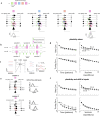Representational drift as the consequence of ongoing memory storage
- PMID: 40739304
- PMCID: PMC12311018
- DOI: 10.1038/s41598-025-11102-x
Representational drift as the consequence of ongoing memory storage
Abstract
Memory systems with biologically constrained synapses have been the topic of intense theoretical study for over thirty years. Perhaps the most fundamental and far-reaching finding from this work is that the storage of new memories implies the partial erasure of already-stored ones. This overwriting leads to a decorrelation of sensory-driven activity patterns over time, even if the input patterns remain similar. Representational drift (RD) should therefore be an expected and inevitable consequence of ongoing memory storage. We tested this hypothesis by fitting a network model to data from long-term chronic calcium imaging experiments in mouse hippocampus. Synaptic turnover in the model inputs, consistent with the ongoing encoding of new activity patterns, accounted for the observed statistics of RD. This mechanism also provides a parsimonious explanation for the diverse effects of experience on drift found in experiment. Our results suggest that RD should be observed wherever neuronal circuits are involved in a process of ongoing learning or memory storage.
© 2025. The Author(s).
Conflict of interest statement
Declarations. Competing interests: The authors declare no competing interests.
Figures






References
-
- Hebb, D. The Organization of Behavior (John Wiley and Sons, 1949).
-
- Amit, D., Gutfreund, H. & Sompolinsky, H. Spin-glass models of neural networks. Phys. Rev. A32, 1007–1018 (1985). - PubMed
-
- Tsodyks, M. & Feigel’man, M. The enhanced storage capacity in neural networks with low activity level. Europhys. Lett.6, 101–105 (1988).
-
- Amit, D. & Fusi, S. Constraints on linearning in dynamics synapses. Netw. Comput. Neural Syst.3, 443–464 (1992).
MeSH terms
Substances
Grants and funding
LinkOut - more resources
Full Text Sources
Medical
Miscellaneous

